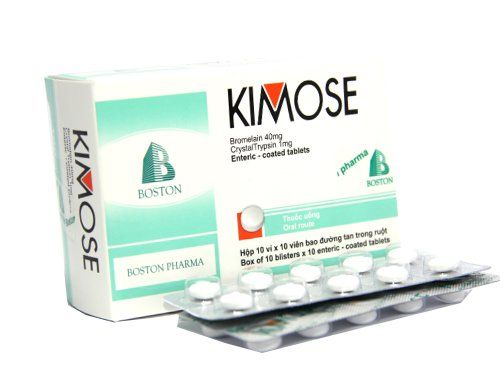Fraxiparine 0.4ml is an injectable medication that contains Nadroparin Calcium. It is used to prevent and treat blood clots, especially during general surgeries and orthopedic surgeries.
1. What is Fraxiparin?
Fraxiparine 0.4ml contains Nadroparin Calcium, which has 3800 anti-Xa IU/0.4ml. Nadroparin is a type of low molecular weight heparin that works as an anticoagulant, helping to prevent blood clots. It works by binding to Antithrombin III, a natural substance in the blood, which enhances its ability to inhibit Factor Xa. This results in quick prevention of blood clotting.
Fraxiparine 0,4ml has minimal effect on platelets, does not block thrombin, and therefore carries a lower risk of causing bleeding. It also has anti-inflammatory effects and helps regulate certain proteins in the body that could contribute to allergic reactions or fluid balance.
Indications for Fraxiparine:
- To prevent blood clots, such as in conditions like deep vein thrombosis or pulmonary embolism.
- Used in orthopedic or general surgery to prevent blood clots from forming.
- During hemodialysis, to prevent clotting in the dialysis circuit.
- To dissolve deep vein thrombosis blood clots.
- To treat conditions like unstable angina or non-Q wave myocardial infarction.
Contraindications:
- If you are allergic to Nadroparin or any ingredient in Fraxiparine.
- If you have had heparin-induced thrombocytopenia, a condition where blood platelet levels drop due to heparin.
- If you have active bleeding or conditions like gastric ulcers or brain hemorrhage.
2. How to use Fraxiparine 0.4ml
Administration: Fraxiparine 0.4ml is given as a subcutaneous injection (injected under the skin), which should be done by a healthcare professional in a hospital or medical setting. Do not inject it yourself at home.
Dosage:
To prevent blood clots:
Follow the dosage prescribed by your doctor.
For orthopedic surgery:
- For patients under 50kg: Inject 0.2ml before and 12 hours after surgery. Then, inject 0.2ml daily for the next 3 days, and increase to 0.3ml from day 4.
- For patients 50-60kg: Inject 0.3ml before and 12 hours after surgery. Then, inject 0.3ml daily for the next 3 days, and increase to 0.4ml from day 4.
- For patients over 70kg: Inject 0.4ml before and 12 hours after surgery. Then, inject 0.4ml daily for the next 3 days, and increase to 0.6ml from day 4.
For general surgery:
- Normally: Inject 0.3ml 2-4 hours before surgery and continue with 0.3ml daily until the patient can walk, for at least 7 days.
- For patients at high risk: Inject 0.6ml daily for those over 70kg, and 0.4ml daily for those under 70kg.
For Hemodialysis:
Inject into the artery before starting dialysis.
- For patients at low risk of bleeding: Under 50kg (0.3ml), 50-69kg (0.4ml), over 70kg (0.6ml).
- For patients at high risk of bleeding: Reduce the dose by half.
For existing blood clots:
Start with an oral anticoagulant, then inject Fraxiparine every 12 hours for about 10 days.
- 0.4ml for those under 50kg, 0.5ml for 50-59kg, 0.6ml for 60-69kg, and 0.7ml for those over 70kg.
For unstable angina and non-q wave myocardial infarction:
Start with an intravenous injection, then continue with subcutaneous injections every 12 hours. Combine with Aspirin for about 6 days.; 0.4ml for patients under 50kg, 0.5ml for 50-59kg, 0.6ml for 60-69kg, and 0.7ml for those over 70kg.
For kidney disease patients: The dose may need to be adjusted depending on the patient's kidney function.
3. Side Effects of Fraxiparine 0.4ml
When using Fraxiparine 0.4ml, patients may experience some side effects, including:
- Bleeding, decreased platelets, bruising at the injection site, skin damage, allergic reactions.
- Increased aldosterone levels, high potassium, or elevated liver transaminase, which usually return to normal after stopping the medication.
These side effects are rare, but patients should be cautious. If any unusual symptoms appear, the patient should contact their doctor for advice and treatment.
4. Precautions when using fraxiparine 0.4ml
Before and during the use of Fraxiparine 0.4ml, patients should follow these precautions:
- If the patient has kidney problems, the dose may need to be adjusted, especially for severe kidney failure.
- Caution is required for patients who are at risk of bleeding, have high blood pressure, liver or kidney problems, a history of stomach ulcers, or conditions that may cause bleeding. Patients who have had eye, brain, or spinal surgery should be closely monitored.
- People with kidney problems, diabetes, or those using drugs that raise potassium levels should have their potassium levels checked while using Fraxiparine.
- If the patient is using an epidural or has had spinal procedures, the risk of bleeding around the spinal cord may increase. This is especially true if the patient is also using drugs that affect blood clotting.
- Fraxiparine should be avoided during pregnancy or breastfeeding unless absolutely necessary, and only under a doctor’s strict supervision.
5. Drug interactions with fraxiparine 0.4ml
Fraxiparine 0.4ml can interact with other medications, including:
- Non-steroidal anti-inflammatory drugs, Salicylates, Ticlopidine, and similar drugs can increase the risk of bleeding. These should be avoided or used carefully with Fraxiparine.
- If Fraxiparine is used with oral blood thinners or steroid medications, the patient’s blood clotting levels should be closely monitored.
- Combining Fraxiparine with other blood thinners or anti-platelet medications can also increase bleeding risks.
- Gentamicin, Cephaloridine, and Colistin may reduce the effectiveness of Fraxiparine.
Summary, Fraxiparine 0.4ml is an injectable medication that contains Nadroparin Calcium, which is used to prevent and treat blood clots, especially during surgeries. Patients should always follow their doctor’s instructions carefully to reduce the risk of side effects and improve treatment outcomes. Regular health checks are essential, particularly if taking other medications at the same time.
To arrange an appointment, please call HOTLINE or make your reservation directly HERE. You may also download the MyVinmec app to schedule appointments faster and manage your reservations more conveniently.
To arrange an appointment, please call HOTLINE or make your reservation directly HERE. You may also download the MyVinmec app to schedule appointments faster and manage your reservations more conveniently.








